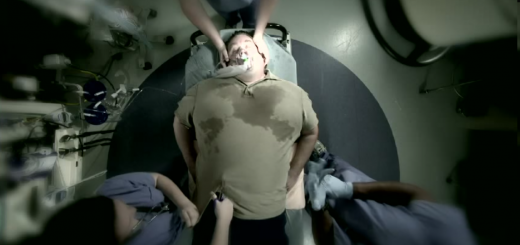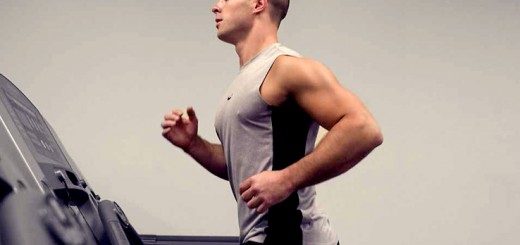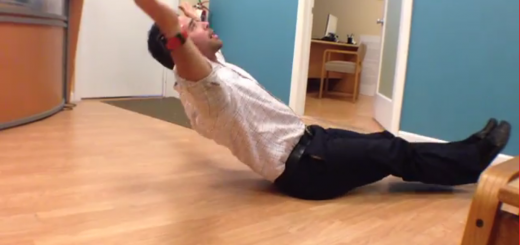5 Reasons to Memorize the Word ‘Fascia’
Your fascial system is integral to your workout performance, not just your muscles. Athlete, know thy anatomy!
You may be noticing the word “fascia” (aka connective tissue) is a hot topic right now in all body related fields. But before we get to why fascia matters to athletes, here is a brief primer about why it’s getting so much attention these days.
First, many think of fascia as a glorified body stocking – a seamless piece of tissue that Saran wraps you just underneath the skin. While this is true of the superficial fascia, it’s important to understand it is a richly multi-dimensional tissue that forms your internal soft tissue architecture.
 From the superficial (“body stocking”) fascia, it dives deep and forms the pods (called fascicles) that actually create your musculature like a honeycomb from the inside out. Imagine what it looks like when you bite into a wedge of orange and then look at those individually wrapped pods of juice. We’re like that too! Fascia also connects muscle to bone (tendons are considered a part of the fascial system), and bone to bone (ligaments are also considered a part of the fascial system), slings your organ structures, cushions your vertebrae (yep, your discs are considered a part of this system, too), and wraps your bones.
From the superficial (“body stocking”) fascia, it dives deep and forms the pods (called fascicles) that actually create your musculature like a honeycomb from the inside out. Imagine what it looks like when you bite into a wedge of orange and then look at those individually wrapped pods of juice. We’re like that too! Fascia also connects muscle to bone (tendons are considered a part of the fascial system), and bone to bone (ligaments are also considered a part of the fascial system), slings your organ structures, cushions your vertebrae (yep, your discs are considered a part of this system, too), and wraps your bones.
So imagine for a moment you could remove every part of you that is not fascia. You would have a perfect 3D model of exactly what you look like. Not just in recognizable ways like your posture or facial features, but also the position of your liver, and the zig-zig your clavicle takes from that break you had as a kid, and how your colon wraps. To say it’s everywhere is far from over-stating things.
In fact, it turns out fascia’s everywhere-ness is one of the reasons it was overlooked for so long. Until recently it was viewed as the packing peanuts of soft tissue. Therefore, in dissections for study and for research, most of it was cleanly scraped away and thrown in a bucket so the cadavers could be tidily made to resemble the anatomical texts from which people were studying. Poor, misunderstood, and underrated fascia. Sigh.
Fortunately research is catching up to what turns out to be a remarkably communicative sensory and proprioceptive tissue. What fascia researchers are discovering is pretty amazing not just for fascia nerds like me, but for anyone who wants to put their body to good, healthy use. (Like, for example, all of us at Breaking Muscle!) So without further ado, here is some of the newly emerging information about fascia and how you can use it to maximize not just your athletic performance, but also just your plain old ability to feel good in your body.
1. Fascia is a tensional fluid system.
 While it’s difficult for us to understand how a support structure could be a fluid structure – because we’re not exactly making hi-rise buildings out of Jell-O – it’s true. Juicy fascia is happy fascia. The best analogy I can give is of a sponge. When a sponge dries out it becomes brittle and hard. It can easily be broken with only a little force because of how crispy it has become. However, when a sponge is wet and well hydrated it gets springy and resilient. You can crush it into a little ball and it bounces back. You can wring it and twist it, but it is difficult to break.
While it’s difficult for us to understand how a support structure could be a fluid structure – because we’re not exactly making hi-rise buildings out of Jell-O – it’s true. Juicy fascia is happy fascia. The best analogy I can give is of a sponge. When a sponge dries out it becomes brittle and hard. It can easily be broken with only a little force because of how crispy it has become. However, when a sponge is wet and well hydrated it gets springy and resilient. You can crush it into a little ball and it bounces back. You can wring it and twist it, but it is difficult to break.
Once we understand that we’re like that on the inside, keeping our fascia hydrated takes on more importance. Our mobility, integrity, and resilience are determined in large part by how well hydrated our fascia is. In fact, what we call “stretching a muscle” is actually the fibers of the connective tissue (collagen) gliding along one another on the mucous-y proteins called glycosaminoglycans (GAGs for short). GAGs, depending on their chemistry, can glue layers together when water is absent, or allow them to skate and slide on one another when hydrated.1,2 This is one of the reasons most injuries are fascial. If we get “dried out” we are more brittle and are at much greater risk for erosion, a tear, or a rupture.
So drink more water, right? Well, yes and no. Staying hydrated via drinking continues to be important, but if you have dehydrated fascia it’s more like you have these little kinks in your “hoses” (microvacuoles), and so all that water you drink can’t actually reach the dehydrated tissue and gets urinated away, never having reached the crispy tissue. To be able to get the fluid to all of your important nooks and crannies you need to first get better irrigated (via the microvacuoles.3 And to do that, you’ve got to get work on your soft tissue to untangle those gluey bits.
Seeing a body worker who specializes in any form of myofascial work (Rolfing or other forms of Structural Integration and ART tend to be faves) will do the trick, but you can also work on this at home with the array of self-care tools for working your own fascia. As I pointed out in last month’s post, I don’t like harder tools as they are less effective at actually “unkinking your hoses”, and Yoga Tune Up Therapy Balls and The MELT Methodare my two favorite self-fascia-lovin’ systems.
2. Variation matters.
 Movement also gets the hydration out to the tissue as well, but thatmovement needs to be varied. This means variation not just of the movements themselves, but also variation of tempo. Not only does moving constantly in the same ways and in the same planes put you at further risk for joint erosion (a là osteoarthritis), but you are also dehydrating the fascia in a particular pattern, thus setting you up for that brittle tissue that injuries love so much.
Movement also gets the hydration out to the tissue as well, but thatmovement needs to be varied. This means variation not just of the movements themselves, but also variation of tempo. Not only does moving constantly in the same ways and in the same planes put you at further risk for joint erosion (a là osteoarthritis), but you are also dehydrating the fascia in a particular pattern, thus setting you up for that brittle tissue that injuries love so much.
As Tom Myers, fascial educator and creator of Anatomy Trains, says in this video:
“Rest is how the tissues rehydrate. When you do heavy exercise you are driving the water out of the tissue in the same way that if you step on a wet beach you push the water out of the sand, and when you pick up your foot the water seeps back into that sand. You’re doing the same thing with tissues, when you’re really working out you are driving the water out of the tissue while you are working…The rhythm [of your fitness regimen] should include some rest… When you take the strain off of the tissues, like a sponge they will suck up that water and be ready for more exercise.”
This certainly makes a good argument for functional fitness work like MovNat that takes its inspiration, wisely, from the constantly varying movements of our ancestors, and also shines a light on the benefits of a good high intensity interval training (HIIT) program.
3. It’s all connected.
Let’s say, for example, that you are in your kitchen and your leg is in your bedroom. This is an example of not being connected. You may also notice it’s an example of a potential plotline for Dexter. Something has gone horribly wrong in this scenario.
Okay, okay, so we were not dropped on our heads as children and we get it that our parts aren’t detachable. But the problem comes when we think of them as attachable. Because of the way we all learn and study anatomy – whether the extent of your studying was singing “the hip bone’s connected to the thigh bone!” song in preschool, or something more extensive – we conceive of human bodies as “attached” by magical soft tissue versions of tape.
 In anatomy-speak we describe all muscles as having an origin and an insertion. So for example, the gastrocnemius muscle (our most superficial calf muscle) originates on the lateral and medial condyles of the femur (thigh) bone, and inserts on the calcaneus (heel bones), via the Achilles tendon. It makes it sound like it is taped or stapled to be “attached” at its origin and insertion points – like it’s this separate thing that gets stuck onto other separate things. A more clear and true to human anatomy description would be that the gastrocnemius becomes the Achilles tendon (by weaving more densely until muscle becomes tendon) and that thenbecomes the calcaneus bone (by weaving more densely until tendon becomes bone).
In anatomy-speak we describe all muscles as having an origin and an insertion. So for example, the gastrocnemius muscle (our most superficial calf muscle) originates on the lateral and medial condyles of the femur (thigh) bone, and inserts on the calcaneus (heel bones), via the Achilles tendon. It makes it sound like it is taped or stapled to be “attached” at its origin and insertion points – like it’s this separate thing that gets stuck onto other separate things. A more clear and true to human anatomy description would be that the gastrocnemius becomes the Achilles tendon (by weaving more densely until muscle becomes tendon) and that thenbecomes the calcaneus bone (by weaving more densely until tendon becomes bone).
I am not just trying to belabor anatomy semantics. This is important because it gives us a handier understanding of how you just plain can’t have something happen to one “part” of your body and not have it affect every other “part” of your body, albeit in varying degrees of intensity. Often in the fascia-geek worlds we’ll use the example of wearing a tightly knit sweater. If you tug on one end of that sweater, you see the tug travel long distance to other ends of the sweater. For athletes, this brings the dreaded domino effect into a clearer perspective.
Many of you have experienced the domino effect without having had a name for it. First, your neck gets injured in a minor whiplash in that teeny tiny no big deal car accident that you had when you were sixteen years old. But you’re sixteen years old, so no biggie. You ignore it and it gets better. But once you enter college, suddenly you have this nagging shoulder pain with all the extra typing and sitting you’re doing. As the years go by you start to think of yourself as the “tight-shouldered” person, and sometimes you have a pinching pain when you lift your arm. More years go by and you are now not only a “tight-shouldered person,” but you also suffer from occasional low back spasms and have developed plantar fasciitis, which you assume must be because you’re a runner and everyone says running is bad for you. I could go on, and this is just one quick sketch of one type of domino effect out of the infinite possibilities, but you get the idea.
The thing this person is experiencing is actually the long, slow drain of an unaddressed compensatory pattern on a body, but in our culture we call it, “just getting old.” The best way to avoid the domino effect is to keep your fascia healthy so that nothing gets jumbled up in the knit of the “sweater” and you are therefore at much lower risk for developing a compensatory pattern which, by its very nature, is always going to be global.
4. Its springiness wants to help you out.
 What do you get when you add juiciness to connectedness? Springiness! When your tissue retains (or regains) its natural spring, the rebound effect of the fascia allows you to use less muscle power, and therefore fatigue less rapidly. Want to jump higher, run faster, and throw farther? You’ll need to pay attention to nourishing the elastic quality of your fascia.
What do you get when you add juiciness to connectedness? Springiness! When your tissue retains (or regains) its natural spring, the rebound effect of the fascia allows you to use less muscle power, and therefore fatigue less rapidly. Want to jump higher, run faster, and throw farther? You’ll need to pay attention to nourishing the elastic quality of your fascia.
For example, when you run with healthy fascia the force you transmit into the ground gets returned to you through the whole tensional network of the fascia. It’s like you have a little built-in trampoline action going on. So once you’ve done the work to rehydrate your tissue, you’ll want to embrace bouncy movements. Some good examples of how you can best play with this arerunning, jumping rope, box jumps, and kettlebells. All martial arts forms also rely on the inner spring. That’s why they’re so cool.
5. It is the largest and richest sensory organ of the body.
Now this little tidbit of recent fascial research was a shocker. It turns out fascia is one of our richest sensory organs with between six to ten times higher quantity of sensory nerve receptors than the muscles.4 In fact, it is possible fascia may be equal or superior to the retina, which has so far been considered the richest human sensory organ.5
This makes your fascia a system of proprioception – i.e. of knowing where your body is in space, but also of graceful full body orchestration of movement. Therefore, well-hydrated and supple fascia is crucial to maintaining your natural settings for alignment and function. And maintaining those natural settings will keep small problems from snowballing into larger ones, keep injuries from becoming chronic issues that flare in and out of life, and keep you mobile and functional for longer through life – as in moving well, but also the perks of that, some of which are avoiding nasty surgeries and joint replacements.
While it’s impossible to not be using at least some of the sensory qualities of fascia (unless you have a disease process that is interfering with it), a way to play with waking up the full potential of your own proprioception is to return, as I already covered, to constantly varied movements. To really Zen-out on noticing your proprioceptive abilities, a barefoot (or minimal footwear) hike over varying terrain mixed with balancing across logs along the way will certainly get the sensory juices flowing. Again, this makes MovNat a great choice.
Whew. And that’s just the tip of the iceberg. But it’s plenty to chew on for now! So go forth, love your fascia, and train happily.
References:
1. Thomas W. Findley, MD, PhD, “Fascia Research From a Clinician/Scientist’s Perspective,” International Journal of Therapeutic Massage and Bodywork, (2011).
2. J.C. Guimberteau, “The Sliding Mechanics of the Subcutaneous Structures in Man Illustration of a Functional Unit: The Microvacuoles,” Studies of the Académie Nationale de Chuirurgie (2005).
3. J.C. Guimberteau, “The Sliding Mechanics of the Subcutaneous Structures in Man Illustration of a Functional Unit: The Microvacuoles,” Studies of the Académie Nationale de Chuirurgie (2005).
4. Robert Schleip et al., Fascia: The Tensional Network of the Human Body (Elsevier, 2012), 77.
5. Robert Schleip et al., Fascia: The Tensional Network of the Human Body (Elsevier, 2012), 77.
Photos courtesy of Shutterstock.
Original Article by: breakingmuscle.com





